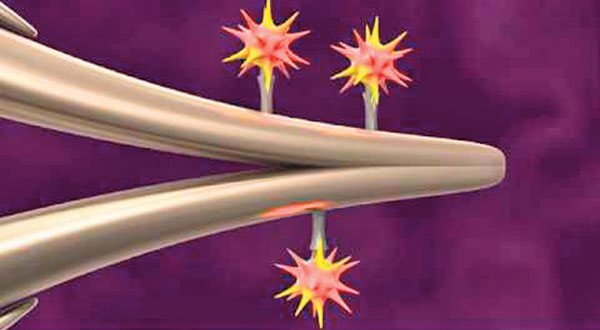The healthy signs
As technology advances, we are provided with inventions that can help solve numerous health problems. You! takes a look at the medical inventions of 2015...
Dengue vaccine
This year the world’s first vaccine against the dengue scourge has been developed and tested. Almost 60 per cent of the 6,000 children were protected against the disease. While these vaccination reductions in dengue fever are considered moderate, they can still translate into a huge benefit for countries plagued by the disease.
Antibody-drug conjugates
The century-old dream of creating magic bullets to fight cancer is almost here. Antibody-drug conjugates represent a promising therapeutic approach for advanced cancer patients by combining the antigen-targeting specificity of monoclonal antibodies with the cytotoxic potency of chemotherapeutic medications that specifically target a protein only found in or around tumour cells. Think of it as precision killing with fewer side effects.
Intraoperative radiation therapy for Breast Cancer
In 2015, a new advancement in breast cancer radiation therapy called intraoperative radiation therapy, or IORT was developed. This is now being used to deliver high doses of radiation during lumpectomies, concentrated only in the cavity where tumours have been removed. It is different from the traditional whole breast radiation, which delivers multiple small doses over many days.
Mobile stroke treatment unit
In order to improve stroke outcomes, a few hospitals in Germany and the US are now using specially equipped mobile stroke treatment ambulances. These high-tech ambulances, with onboard paramedic, critical care nurse, EMT, CT technologist, and virtual stroke neurologist (via telemedicine) are now bringing the emergency department straight to the patient with stroke symptoms. This prevents the effects of stroke before they can lead to permanent brain injury. Imagine how many lives this technology will save if introduced in Pakistan.
Inhibitors for cholesterol reduction...
There are now a new class of cholesterol-lowering drugs - the PCSK9 inhibitors - that are self-injected once or twice a month. The medications work on the cholesterol receptor in the liver by a mechanism that is similar to statins, yet completely unique. Study results with these complex monoclonal antibodies have reported promising data, with LDL (bad) cholesterol levels plummeting by as much as half to two-thirds in patients taking the medication versus those taking placebo.
No-Drill
A new treatment for early cavities, which works by injecting liquid resin into the tooth, is gaining much popularity. The quick-flowing resin reaches the inner ‘lattice’ of decay faster than traditional metal or composite fillings can. Once inside the problem spot, it solidifies and stops the cavity from progressing. There is no anaesthetic and no drilling. The product is currently available in Europe and will soon be found world-over.
 Anti-smoking vaccine
Anti-smoking vaccine
A new vaccine holds promise for 90 per cent of quitters who relapse. After six monthly injections, users of NicVax build up antibodies to nicotine, just as they would to a disease. If you smoke when you’re on it, your bloodstream is flooded with nicotine. The antibodies attach to the nicotine’s molecules, making them too big to cross into the brain’s pleasure centre. Result: smoking buzz officially killed.
A better baby monitor
Sproutling, an invention, is a dream come true for many parents who need assistance in managing a baby. It tracks an infant’s heart rate, body temperature, position, and other variables. If something is wrong, parents can be notified on their smart phones.
Absorbable heart stent
Stents open arteries that are narrowed or blocked because of coronary artery disease. Drug-eluting stents release medication that keeps the artery from narrowing again. The bio-absorbable version made by Abbott Laboratories in Illinois goes one step further: Unlike metal stents, it does its job and disappears. After six months the stent begins to dissolve, and after two years it’s completely gone, leaving behind a healthy artery.
Muscle stimulator
An invention called MyoSpare was launched this year. It is a battery-operated device that uses electrical stimulators - small enough to be worn underneath casts - to exercise muscles and keep them strong during recovery.
Nerve regenerator
Nerve fibres can’t grow along injured spinal cords because scar tissue gets in the way. A nanogel that has been developed eliminates that impediment. Injected as a liquid, the nanogel self-assembles into a scaffold of nanofibres. Peptides expressed in the fibres instruct stem cells that would normally form scar tissue to produce cells that encourage nerve development.
Walking simulator
Stroke victims are being tricked into recovering more quickly with a virtual-reality rehabilitation programme. As patients walk on a treadmill, they see moving images that fool their brains into thinking they are walking slower than they are. As a result, patients not only walk faster and farther, but experience less pain while doing so.
Rocket-powered arm
Adding strength to prosthetic limbs has typically required bulky battery packs. Vanderbilt University scientist Michael Goldfarb came up with an alternative power source: rocket propellant. Goldfarb’s prosthetic arm can lift 20 pounds - three to four times more than current prosthetics - thanks to a pencil-size version of the mono-propellant rocket-motor system used to manoeuvre the space shuttle in orbit.